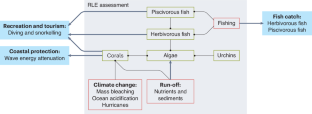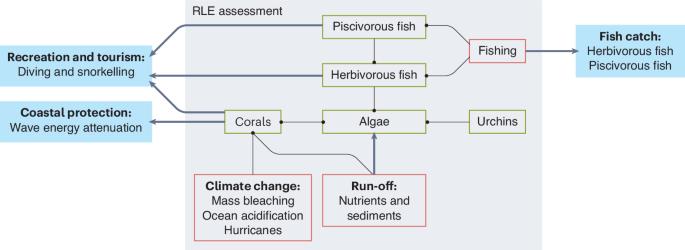Synergies and complementarities between ecosystem accounting and the Red List of Ecosystems
IF 13.9
1区 生物学
Q1 ECOLOGY
引用次数: 0
Abstract
Safeguarding biodiversity and human well-being depends on sustaining ecosystems. Two global standards for quantifying ecosystem change, the International Union for Conservation of Nature Red List of Ecosystems (RLE) and the United Nations System of Environmental-Economic Accounting Ecosystem Accounting (EA), underpin headline indicators for the Kunming–Montreal Global Biodiversity Framework. We analyse similarities and differences between the standards to understand their complementary roles in environmental policy and decision-making. The standards share key concepts, definitions of ecosystems and spatial data needs, meaning that similar data can be used in both. Their complementarities stem from their differing purposes and thus how data are analysed and interpreted. Although both record changes in ecosystem extent and condition, the RLE analyses the magnitude of change in terms of risk of ecosystem collapse and biodiversity loss, whereas EA links ecosystem change with the ecosystem’s contributions to people and the economy. We recommend that the RLE and EA should not be treated as unrelated nor undertaken in isolation. Developing them in concert can exploit their complementarities while ensuring consistency in foundational data, in particular ecosystem classifications, maps and condition variables. Finding pathways for co-investment in foundational data, and for knowledge-sharing between people and organizations who undertake RLE assessments and accounting, will improve both processes and outcomes for biodiversity, ecosystems and people. This Perspective discusses how two global standards for quantifying ecosystem change—the IUCN Red List of Ecosystems and UN System of Environmental-Economic Accounting Ecosystem Accounting—should be used in tandem to optimize their complementarities in assessing ecosystems and to further develop both processes.


生态系统核算与生态系统红色名录之间的协同作用和互补性
保护生物多样性和人类福祉取决于维持生态系统。量化生态系统变化的两个全球标准,即《国际自然保护联盟生态系统红色名录》(RLE)和《联合国环境经济核算体系生态系统核算》(EA),是昆明-蒙特利尔全球生物多样性框架主要指标的基础。我们分析了这些标准之间的异同,以了解它们在环境政策和决策中的互补作用。这些标准共享关键概念、生态系统定义和空间数据需求,这意味着类似的数据可用于这两种标准。它们之间的互补性源于各自不同的目的,以及分析和解释数据的方式。虽然两者都记录生态系统范围和状况的变化,但 RLE 从生态系统崩溃和生物多样性丧失的风险角度分析变化的程度,而 EA 则将生态系统变化与生态系统对人类和经济的贡献联系起来。我们建议,不应将 RLE 和 EA 割裂开来对待。协同开发可利用它们的互补性,同时确保基础数据的一致性,特别是生态系统分类、地图和状况变量。找到对基础数据进行共同投资的途径,以及在进行 RLE 评估和核算的人员和组织之间进行知识共享的途径,将改善生物多样性、生态系统和人类的进程和结果。
本文章由计算机程序翻译,如有差异,请以英文原文为准。
求助全文
约1分钟内获得全文
求助全文
来源期刊

Nature ecology & evolution
Agricultural and Biological Sciences-Ecology, Evolution, Behavior and Systematics
CiteScore
22.20
自引率
2.40%
发文量
282
期刊介绍:
Nature Ecology & Evolution is interested in the full spectrum of ecological and evolutionary biology, encompassing approaches at the molecular, organismal, population, community and ecosystem levels, as well as relevant parts of the social sciences. Nature Ecology & Evolution provides a place where all researchers and policymakers interested in all aspects of life's diversity can come together to learn about the most accomplished and significant advances in the field and to discuss topical issues. An online-only monthly journal, our broad scope ensures that the research published reaches the widest possible audience of scientists.
 求助内容:
求助内容: 应助结果提醒方式:
应助结果提醒方式:


